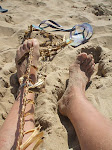Added bonuses were the documentary films. One recent film included a clip about rush weavers in East Anglia
The degree to which baskets and basketry have been culturally constructive is a fascinating and highly debatable topic. It was the theme for the multi disciplinary conference, 'Basketry and Beyond: Constructing Cultures' held at UEA last week and was explored intensively by the group of international speakers which included archaeologists, art historians, basket makers, environmental artists, ethnographers, biologists and neuroscientists - to name a few. It was mental gym of the best sort. My favourite topic, i.e. basketry explored in directions that I am unlikely to have considered in any other situation. It was high quality brain food and I came away exhausted but replete and very inspired in terms of thinking and making. It seems strange that one can come up with visual ideas after listening to people talk but it sometimes happens and is very exciting when it does.
 Prior to the conference I ran a coiling and looping workshop for two days at the Sainsbury Centre which resulted in some very creative experiments by the 15 students. It is always a pleasure to look at all the work at the end of these workshops and see how different each piece is. All the students are taught the same techniques but, because they have brought their own materials and personalities to the workshop, no two pieces are ever alike.
Prior to the conference I ran a coiling and looping workshop for two days at the Sainsbury Centre which resulted in some very creative experiments by the 15 students. It is always a pleasure to look at all the work at the end of these workshops and see how different each piece is. All the students are taught the same techniques but, because they have brought their own materials and personalities to the workshop, no two pieces are ever alike. In the ‘show and tell’ at the end of a workshop I ask the students to tell each other about their experiences over the two days and to comment on anyone else’s work if they want to. This is always rewarding to do. Invariably, someone in the group who seems to feel that they have not done anything particularly special, gets singled out by their fellow students, for having created something that touches them. Even though I may have said that I like what they have done, it always means so much more to that particular student to hear it from their peers rather than to hear it from me.
In the ‘show and tell’ at the end of a workshop I ask the students to tell each other about their experiences over the two days and to comment on anyone else’s work if they want to. This is always rewarding to do. Invariably, someone in the group who seems to feel that they have not done anything particularly special, gets singled out by their fellow students, for having created something that touches them. Even though I may have said that I like what they have done, it always means so much more to that particular student to hear it from their peers rather than to hear it from me.
One thing bothers me though why is it usually only women that come to these workshops?
During the conference, speakers referred to the division of labour between the sexes that traditionally goes on with basket making in many cultures. Often if the women used the baskets, they made them, and conversely if the men used them. Consequently, you could almost say that if the basket was going to be used indoors it would be made by women, and if used outdoors made by men. Perhaps this is still true, as I note that last week in Galicia









No comments:
Post a Comment